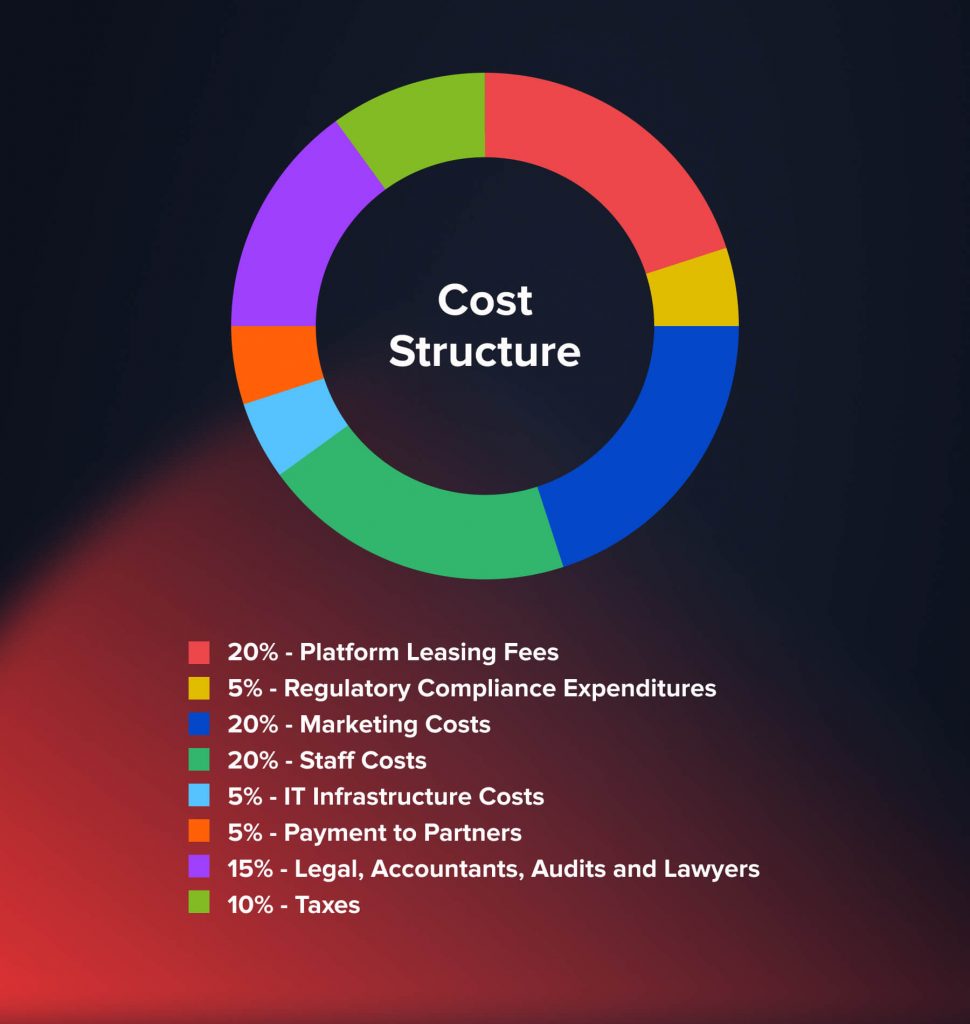
Como iniciar uma empresa de prop-trading de marca branca do zero? O guia definitivo
Conteúdo
Prop-trading é quando empresas financeiras ou traders usam seu próprio dinheiro para negociar em vez de receber taxas de negociações de clientes, como fazem as corretoras convencionais. Diferentemente dos modelos de corretagem, no prop-trading os traders buscam lucros diretos no mercado por meio da aquisição de posições distintas no mercado, e não a facilitação de negociações com clientes. Este guia detalhado esclarece os aspectos críticos doo prop-trading de marca branca e descreve as etapas práticas para dar início a esse empreendimento.
Como iniciar uma plataforma de prop-trading de marca branca em 8 etapas
- Entender o quadro regulatório
- Adquirir as licenças necessárias.
- Realizar pesquisas e selecionar o provedor de marca branca apropriado
- Negociar os termos/assinatura do contrato
- Personalizar sua plataforma
- Testar a plataforma
- Conduzir análise de desempenho
- Monitoramento de compliance
You may also like

Como iniciar uma empresa de prop-trading de marca branca?
Aventurar-se no mundo do prop-trading de marca branca requer uma abordagem bem-pensada para garantir o sucesso e a conformidade com várias regulamentações financeiras. Entender como navegar nas águas turbulentas do cenário regulatório é crucial para futuros empresários. A compliance, ou a falta dela, reflete fortemente na reputação da empresa e pode custar milhões de dólares em honorários advocatícios. Aqui está uma análise mais aprofundada das oito etapas necessárias para embarcar neste empreendimento empresarial:
1. Entender o quadro regulatório
É essencial que você esteja ciente das regulamentações que regem o prop-trading no local onde você planeja estabelecer uma empresa de prop-trading de marca branca. Por exemplo, é fundamental conhecer as regulamentações estabelecidas pela Securities and Exchange Commission (SEC) e pela Commodity Futures Trading Commission (CFTC) nos Estados Unidos. Você pode aprender sobre essas regulamentações em sites governamentais, cursos ou livros sobre regulamentação financeira. Além disso, ser membro de várias organizações do setor pode oferecer uma compreensão mais profunda das regulamentações e conectá-lo com colegas do setor.
2. Adquirir licenças necessárias
Depois de se familiarizar com as regras e regulamentos em vigor, a tarefa seguinte envolve obter as licenças e autorizações necessárias para administrar uma empresa de negociação. Os critérios para essas autorizações podem variar muito dependendo da localização e dos produtos financeiros específicos que você pretende negociar. A obtenção dessas autorizações envolve um processo de solicitação que pode envolver o envio de detalhes abrangentes sobre suas práticas comerciais, estabilidade financeira e a experiência de funcionários essenciais. Além disso, fazer parte de bolsas estabelecidas pode ser necessário para administrar uma empresa de negociação, o que pode conceder acesso a plataformas de negociação e outras ferramentas essenciais para a realização de negociações.
3. Pesquisa e seleção
O passo para a criação de uma empresa de prop-trading de marca branca depende muito da parceria com um fornecedor de marca branca confiável. O primeiro passo é uma pesquisa completa para identificar um provedor com uma plataforma de negociação robusta, um bom histórico e serviços de suporte sólidos. Ler avaliações on-line, obter sugestões de pessoas do setor e explorar as parcerias anteriores do provedor são abordagens sensatas para julgar a confiabilidade e a eficácia de provedores em potencial.
Além disso, é crucial avaliar a capacidade e a facilidade de uso da plataforma de negociação para garantir que ela satisfaça às necessidades das operações de negociação modernas. Além disso, avaliar os serviços de suporte fornecidos pelo provedor, como materiais de treinamento e assistência, é crucial, pois eles ajudam a preservar a eficiência operacional além do lançamento.
4. Negociar os termos
Após escolher o fornecedor, a próxima etapa envolve discutir os detalhes da parceria, o que inclui serviços oferecidos, despesas incorridas e acordos de responsabilidade. Para evitar futuros mal-entendidos, um contrato completo deve especificar deveres e obrigações para sua empresa, bem como para o provedor. Primeiro, é preciso entender as implicações, incluindo custos iniciais, despesas mensais e quaisquer pagamentos adicionais por serviços extras. A proteção legal do seu negócio e a definição do grau de obrigação de cada parte em diferentes circunstâncias dependem da existência de contratos de responsabilidade.
5. Personalizar a plataforma de negociação
A configuração técnica é uma fase crucial no estabelecimento da sua empresa de prop-trading de marca branca. Tudo começa com a adaptação da plataforma de negociação fornecida pelo provedor de marca branca para que ela ressoe com a identidade da sua marca e atenda às necessidades específicas da sua clientela. Isso pode envolver a modificação dos elementos de design da plataforma, como logotipos, esquemas de cores e interface do usuário para alinhá-los ao tema da sua marca, bem como ajustar sua funcionalidade para garantir que ela atenda aos seus clientes de forma eficaz.
6. Testar
Testes completos são necessários para determinar o desempenho e a confiabilidade da plataforma depois que a modificação for concluída. Esta fase de testes deve ter como objetivo identificar e corrigir quaisquer problemas técnicos ou falhas que possam prejudicar as operações de negociação. É prudente simular cenários de negociação reais para verificar como a plataforma lida com diferentes condições de mercado e volumes de negociação. Corrigir quaisquer deficiências descobertas durante os testes garantirá que sua plataforma de negociação esteja robusta e pronta para o lançamento.
7. Análise de desempenho
Administrar com sucesso uma empresa de prop-trading de marca branca envolve buscar melhorias e seguir as diretrizes regulatórias diligentemente. Comece avaliando a eficácia de suas atividades de negociação. Isso inclui analisar os resultados das negociações para identificar padrões e reconhecer oportunidades de melhoria. É crucial entender quais aspectos são bem-sucedidos e quais áreas precisam de atenção para fazer melhores escolhas que melhorem o desempenho.
8. Monitoramento de compliance
Na frente da compliance, é fundamental estabelecer um sistema de monitoramento robusto para garantir que sua empresa atenda continuamente aos requisitos regulatórios. Este sistema deve ajudar você a monitorar a adesão às regras definidas pelas autoridades financeiras e alertá-lo sobre quaisquer discrepâncias. Além disso, como as regulamentações podem evoluir, é crucial manter-se atualizado sobre quaisquer mudanças no cenário regulatório. Certifique-se de ter um processo para revisar regulamentações novas ou alteradas e ajustar seus procedimentos de compliance adequadamente.
Esse foco duplo na melhoria contínua e no monitoramento vigilante da compliance não apenas aprimora as operações da sua empresa, mas também ajuda a construir e manter uma reputação de integridade e profissionalismo no competitivo mercado de negociação.
Lançar uma empresa de prop-trading de marca branca é um empreendimento complexo, mas gratificante. Ao navegar diligentemente pelas regulamentações, estabelecer uma parceria sólida com um fornecedor de marca branca e garantir a prontidão operacional, os aspirantes a proprietários estabelecem uma base sólida para um empreendimento de negociação de sucesso.
Agora que vimos como configurar sua própria plataforma de prop-trading de marca branca, vamos dar uma olhada no prop-trading como um todo.
Quanto custa para iniciar uma empresa de prop-trading
O gerenciamento financeiro é a base do sucesso no estabelecimento de uma empresa de prop-trading de marca branca. Uma compreensão clara da estrutura de custos e dos potenciais fluxos de receita não apenas facilita um melhor planejamento financeiro, mas também capacita a empresa a navegar pelas complexidades do setor de negociação com uma estratégia fiscal sólida.
Estrutura de custos
A base financeira da empresa é formada por sua estrutura de custos, o que afeta sua viabilidade operacional, bem como suas possibilidades de expansão. Das taxas de locação de plataforma às despesas de compliance regulatória, cada fator de custo é muito importante para determinar a situação financeira da empresa. Vamos examinar esses elementos de custo mais de perto para desenvolver um conhecimento geral que possa orientar o desenvolvimento sustentável e os gastos prudentes.

- Taxas de locação de plataforma: garantir acesso a uma plataforma de negociação confiável por meio de um provedor de marca branca envolve taxas de locação que constituem uma parcela significativa dos custos iniciais e contínuos.
- Custos de marketing: construir uma marca e atrair traders exige uma estratégia de marketing bem-pensada, e os custos associados podem ser substanciais.
- Custos de pessoal: isso abrange despesas relacionadas ao escritório. Salários competitivos são fundamentais para recrutar e reter talentos, e uma força de trabalho competente é essencial para o sucesso operacional.
- Custos de infraestrutura de TI: manter uma infraestrutura de TI robusta e segura é essencial para operações de negociação contínuas e segurança de dados.
- Pagamentos a parceiros: recompensas para corretores de apresentação e outros parceiros são essenciais para aumentar sua base de clientes e manter bons relacionamentos.
- Jurídico, Contadores, Auditores e Advogados: garantir a compliance legal e manter registros financeiros transparentes exigem serviços profissionais que têm um custo.
- Impostos: como qualquer outro negócio, as empresas de prop-trading estão sujeitas a impostos, que precisam ser considerados na estrutura de custos.
Fontes de Receita
A vitalidade financeira de uma empresa de prop-trading de marca branca vai além dos lucros derivados das atividades de negociação. Ao identificar e utilizar cuidadosamente diversas fontes de receita, a situação financeira da empresa pode ser muito melhorada, garantindo um fluxo consistente de renda mesmo em meio à incerteza econômica. As seguintes fontes de renda permitem que as empresas criem um portfólio de renda diversificado, capaz de enfrentar tempestades financeiras e posicionar a empresa em um caminho de lucratividade contínua.
- Comissão do Volume de Negociação: ganhar comissões sobre o volume de negociação gerado pelos seus traders é uma fonte direta de receita.
- Markups de spread: aumentar os spreads pode gerar receita adicional, embora seja essencial permanecer competitivo para não desencorajar os traders.
- Markups em depósitos/retiradas via provedores de serviços de pagamentos e criptomoedas: implementar margens de lucro em transações financeiras pode gerar renda adicional.
- Markup de spread de câmbio e comissão: é possível obter lucros com markups de câmbio de moedas e de comissão.
- Markups de swap: as taxas de swap podem ser aumentadas para gerar receita adicional.
- Outras receitas de corretagem: isso pode abranger uma variedade de outros serviços ou taxas, como taxas de desempenho, taxas de assinatura para serviços adicionais ou contratos de divisão da receita com o provedor.
Os benefícios de uma plataforma de marca branca
A natureza colaborativa do modelo de prop-trading de marca branca traz vários benefícios para a empresa de marca branca, principalmente a redução significativa nos requisitos de capital e nos desafios operacionais. Esse modelo essencialmente proporciona uma entrada mais rápida no mercado, economizando tempo e recursos que, de outra forma, seriam gastos no estabelecimento de sistemas do zero.
O modelo também permite aproveitar a infraestrutura tecnológica e regulatória estabelecida pelo provedor, o que são vantagens significativas, já que tecnologia e compliance são pilares fundamentais nas operações de negociação. Esse acesso aumenta a eficiência operacional e gera confiança entre clientes e partes interessadas.
Além disso, as plataformas de marca branca permitem adaptabilidade e crescimento mais fáceis. Isso é crucial para uma empresa que deseja se expandir e se adaptar ao mercado e às necessidades de seus clientes e traders. Uma plataforma de marca branca permite que a empresa expanda as classes de ativos oferecidas sem investimentos significativos adicionais na infraestrutura original da empresa.
Além disso, o modelo promove um ambiente mutuamente benéfico para o provedor e o operador de marca branca. A troca de conhecimentos e recursos aumenta a penetração no mercado e o sucesso financeiro, criando um ambiente de negociação mais próspero. Essa colaboração beneficia não apenas as duas entidades envolvidas, mas também seus clientes, que terão melhores serviços e opções de negociação.
Em essência, o modelo de prop-trading de marca branca acelera a criação de uma empresa de negociação e cria um ambiente propício para o crescimento mútuo e o sucesso no competitivo mercado de negociação. Por meio de recursos e experiência compartilhados, tanto o provedor quanto o operador de marca branca têm o potencial de prosperar e fazer avanços significativos no cenário de mercado.
Conclusão
A criação de uma empresa de prop-trading de marca branca envolve planejamento estratégico, diretrizes regulatórias e habilidades operacionais. Este modelo de negócio oferece aos aspirantes a proprietários uma maneira sólida de mergulhar em atividades de prop-trading com menos risco, graças ao suporte da infraestrutura da empresa principal. Com planejamento cuidadoso, execução habilidosa e aprendizado contínuo, os aspirantes a proprietários estão bem-posicionados para navegar no complexo mundo dos mercados financeiros e deixar uma marca notável no campo de prop-trading.
Atualizado:
27 de março de 2025




